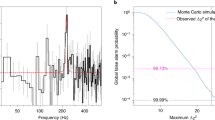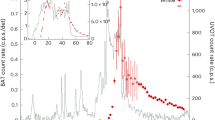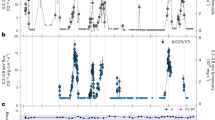Abstract
In the optical sky, minutes-duration transients from cosmological distances are rare. Known objects that give rise to such transients include gamma-ray bursts (GRBs), the most luminous explosions in the Universe1 that have been detected at redshifts as high as z ≈ 9.4 (refs. 2,3,4). These high-redshift GRBs and their associated emission can be used to probe the star formation and reionization history in the era of cosmic dawn. Here, we report a near-infrared transient with an observed duration shorter than 245 s that is coincident with the luminous star-forming galaxy GN-z11 at z ≈ 11. The telluric absorption shown in the near-infrared spectrum indicates that its origin is above the Earth’s atmosphere. We can rule out the possibility of known man-made objects or moving objects in the Solar System on the basis of the observational information and our current understanding of the properties of these objects. As some long-duration GRBs are associated with a bright ultraviolet or optical flash5,6,7,8,9,10,11,12,13,14, we investigate the possibility that the detected signal arose from a rest-frame ultraviolet flash associated with a long GRB from GN-z11. Despite the very low probability of being a GRB, we find that the spectrum, brightness and duration of the transient are consistent with such an interpretation. Our result may suggest that long GRBs can be produced as early as 420 million years after the Big Bang.
This is a preview of subscription content, access via your institution
Access options
Access Nature and 54 other Nature Portfolio journals
Get Nature+, our best-value online-access subscription
$29.99 / 30 days
cancel any time
Subscribe to this journal
Receive 12 digital issues and online access to articles
$119.00 per year
only $9.92 per issue
Buy this article
- Purchase on Springer Link
- Instant access to full article PDF
Prices may be subject to local taxes which are calculated during checkout


Similar content being viewed by others
Data availability
The Keck MOSFIRE data of this work are publicly available from the Keck Observatory Archive (https://www2.keck.hawaii.edu/koa/public/koa.php). The long GRBs used for a simulation are publicly available from a GRB archive website (https://swift.gsfc.nasa.gov/archive/grb_table.html/). Source data are provided with this paper. Other data of this study are available from the corresponding authors upon reasonable request.
Code availability
The Keck MOSFIRE data were reduced using a publicly available data reduction pipeline (https://github.com/Keck-DataReductionPipelines/MosfireDRP). The GN-z11-flash spectra were extracted and calibrated using standard IRAF routines (https://iraf-community.github.io/).
References
Kumar, P. & Zhang, B. The physics of gamma-ray bursts & relativistic jets. Phys. Rep. 561, 1–109 (2015).
Tanvir, N. R. et al. A γ-ray burst at a redshift of z ≈ 8.2. Nature 461, 1254–1257 (2009).
Salvaterra, R. et al. GRB090423 at a redshift of z ≈ 8.1. Nature 461, 1258–1260 (2009).
Cucchiara, A. et al. A photometric redshift of z ≈ 9.4 for GRB 090429B. Astrophys. J. 736, 7–18 (2011).
Akerlof, C. et al. Observation of contemporaneous optical radiation from a γ-ray burst. Nature 398, 400–402 (1999).
Vestrand, W. T. et al. A link between prompt optical and prompt γ-ray emission in γ-ray bursts. Nature 435, 178–180 (2005).
Racusin, J. L. et al. Broadband observations of the naked-eye γ-ray burst GRB080319B. Nature 455, 183–188 (2008).
Japelj, J. et al. Phenomenology of reverse-shock emission in the optical afterglows of gamma-ray bursts. Astrophys. J. 785, 84–105 (2014).
Troja, E. et al. Significant and variable linear polarization during the prompt optical flash of GRB 160625B. Nature 547, 425–427 (2017).
Mészáros, P. & Rees, M. J. Optical and long-wavelength afterglow from gamma-ray bursts. Astrophys. J. 476, 232–237 (1997).
Sari, R. & Piran, T. Predictions for the very early afterglow and the optical flash. Astrophys. J. 520, 641–649 (1999).
Zhang, B., Kobayashi, S. & Mészáros, P. Gamma-ray burst early optical afterglows: implications for the initial Lorentz factor and the central engine. Astrophys. J. 595, 950–954 (2003).
Kumar, P. & Panaitescu, A. What did we learn from gamma-ray burst 080319B? Mon. Not. R. Astron. Soc. 391, L19–L23 (2008).
Shen, R. & Zhang, B. Prompt optical emission and synchrotron self-absorption constraints on emission site of GRBs. Mon. Not. R. Astron. Soc. 398, 1936–1950 (2009).
Oesch, P. A. et al. A remarkably luminous galaxy at z = 11.1 measured with Hubble Space Telescope grism spectroscopy. Astrophys. J. 819, 129–139 (2016).
McLean, I. S. et al. MOSFIRE, the Multi-object spectrometer for infra-red exploration at the Keck Observatory. In Proc. SPIE 8446, 84460J (2012).
Jiang, L. et al. Evidence for GN-z11 as a luminous galaxy at redshift 10.957. Nat. Astron. (in the press).
Uhm, Z. L. & Zhang, B. Fast-cooling synchrotron radiation in a decaying magnetic field and γ-ray burst emission mechanism. Nat. Phys. 10, 351–356 (2014).
von Kienlin, K. A. et al. The second Fermi GBM gamma-ray burst catalog: the first four years. Astrophys. J. Suppl. Ser. 211, 13–25 (2014).
Qin, Y. et al. A comprehensive analysis of Fermi gamma-ray burst data. III. Energy-dependent T90 distributions of GBM GRBs and instrumental selection effect on duration classification. Astrophys. J. 763, 15–23 (2013).
Zhang, B. The Physics of Gamma-ray Bursts (Cambridge Univ. Press, 2018).
Galama, T. J. et al. An unusual supernova in the error box of the γ-ray burst of 25 April 1998. Nature 395, 670–672 (1998).
Hjorth, J. et al. A very energetic supernova associated with the γ-ray burst of 29 March 2003. Nature 423, 847–850 (2003).
Pian, E. et al. An optical supernova associated with the X-ray flash XRF 060218. Nature 442, 1011–1013 (2006).
Xu, D. et al. Discovery of the broad-lined Type Ic SN 2013cq associated with the very energetic GRB 130427A. Astrophys. J. 776, 98–103 (2013).
Woosley, S. E. & Bloom, J. S. The supernova gamma-ray burst connection. Annu. Rev. Astron. Astrophys. 44, 507–556 (2006).
MacFadyen, A. I. & Woosley, S. E. Collapsars: gamma-ray bursts and explosions in “failed supernovae”. Astrophys. J. 524, 262–289 (1999).
Bromm, V. & Loeb, A. The expected redshift distribution of gamma-ray bursts. Astrophys. J. 575, 111–116 (2002).
Abel, T., Bryan, G. L. & Norman, M. L. The formation of the first star in the universe. Science 295, 93–98 (2002).
Amati, L. et al. The THESEUS space mission concept: science case, design and expected performances. Adv. Space Res. 62, 191–244 (2018).
Kriek, M. et al. The MOSFIRE deep evolution field (MOSDEF) survey: rest-frame optical spectroscopy for ~1500 H-selected galaxies at 1.37 < z < 3.8. Astrophys. J. Suppl. Ser. 218, 15–41 (2015).
Kraft, R. P., Burrows, D. N. & Nousek, J. A. Determination of confidence limits for experiments with low numbers of counts. Astrophys. J. 374, 344–355 (1991).
Gao, H. et al. A complete reference of the analytical synchrotron external shock models of gamma-ray bursts. New Astron. Rev. 57, 141–190 (2013).
Preece, R. D. et al. The BATSE gamma-ray burst spectral catalog. I. High time resolution spectroscopy of bright bursts using high energy resolution data. Astrophys. J. Suppl. Ser. 126, 19–36 (2000).
Williams, G. G. et al. LOTIS upper limits and the prompt OT from GRB 990123. AIP Conf. Proc. 526, 250–254 (2000).
von Kienlin, A. et al. The fourth Fermi-GBM gamma-ray burst catalog: a decade of data. Astrophys. J. 893, 46–59 (2020).
Granot, J. & Sari, R. The shape of spectral breaks in gamma-ray burst afterglows. Astrophys. J. 568, 820–829 (2002).
Sun, H., Zhang, B. & Li, Z. Extragalactic high-energy transients: event rate densities and luminosity functions. Astrophys. J. 812, 33–50 (2015).
Yüksel, H. et al. Revealing the high-redshift star formation rate with gamma-ray bursts. Astrophys. J. 638, 5–8 (2008).
Acknowledgements
We acknowledge support from the National Science Foundation of China (grant nos. 11721303, 11890693 and 11991052), the National Key R&D Program of China (grant nos. 2016YFA0400702 and 2016YFA0400703) and the Chinese Academy of Sciences (CAS) through a China–Chile Joint Research Fund (grant no. 1503) administered by the CAS South America Center for Astronomy. N.K. acknowledges support from the JSPS (grant no. 15H03645). The data presented herein were obtained at the W. M. Keck Observatory, which is operated as a scientific partnership among the California Institute of Technology, the University of California and the National Aeronautics and Space Administration. The Observatory was made possible by the generous financial support of the W. M. Keck Foundation. We wish to recognize and acknowledge the very significant cultural role and reverence that the summit of Mauna Kea has always had within the indigenous Hawaiian community. We are most fortunate to have the opportunity to conduct observations from this mountain. This research has made use of data provided by CalSky.com and by the IAU’s Minor Planet Center.
Author information
Authors and Affiliations
Contributions
L.J. designed the programme, carried out the Keck observations, analysed the data, and prepared the manuscript. S.W. and G.W. reduced the Keck images. B.Z. proposed the theoretical interpretation and helped to prepare the manuscript. N.K. assisted in the design of the programme and carrying out the observations. L.C.H. helped to prepare the manuscript. Y.-S.Y. and B.-B.Z. searched the archival Fermi GBM data. H.-B.Z. searched the IAU Minor Planet Center database. All authors helped with the scientific interpretations and commented on the manuscript.
Corresponding authors
Ethics declarations
Competing interests
The authors declare no competing interests.
Additional information
Peer review information Nature Astronomy thanks Dieter Hartmann and the other, anonymous, reviewers for their contribution to the peer review of this work.
Publisher’s note Springer Nature remains neutral with regard to jurisdictional claims in published maps and institutional affiliations.
Extended data
Extended Data Fig. 1 Line width of the GN-z11-flash 2D spectrum in the spatial direction.
(a) Comparison with a reference star. Each of the 10 blue profiles (centered at x = 10) is the best Gaussian fit to an observed profile at one wavelength position. The observed profile is the stack of 30 individual profiles along the wavelength direction. The 10 black profiles (also centered at x = 10) are the best-fitted profiles at the same positions for a bright reference star on a neighboring slit. The profiles are normalized so that the peak values are about 10. The insets show parts of the 2D spectrum centered at 2.15 and 2.25 μm, respectively. (b) Line profiles of an alignment star. The black profile presents a slit centered on the brightest pixel. The orange, blue, and green profiles present three slits that are off the center by +2, +3, and +4 pixels, respectively. The profiles are normalized so that the peak values are about 10.
Source data
Source Data Fig. 1
Source data for Fig. 1.
Source Data Fig. 2
Source data for Fig. 2.
Rights and permissions
About this article
Cite this article
Jiang, L., Wang, S., Zhang, B. et al. A possible bright ultraviolet flash from a galaxy at redshift z ≈ 11. Nat Astron 5, 262–267 (2021). https://doi.org/10.1038/s41550-020-01266-z
Received:
Accepted:
Published:
Issue Date:
DOI: https://doi.org/10.1038/s41550-020-01266-z
This article is cited by
-
Aggregate effects of proliferating low-Earth-orbit objects and implications for astronomical data lost in the noise
Nature Astronomy (2023)
-
A more probable explanation for a continuum flash towards a redshift ≈ 11 galaxy
Nature Astronomy (2021)
-
Exploring nine simultaneously occurring transients on April 12th 1950
Scientific Reports (2021)
-
GN-z11-flash from a man-made satellite not a gamma-ray burst at redshift 11
Nature Astronomy (2021)
-
L. Jiang et al. reply
Nature Astronomy (2021)



